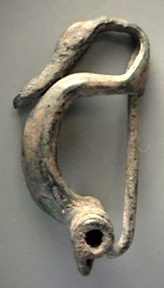I have collected early Celtic art for more than twenty-five years. It is a slow process. Throughout this blog, I will illustrate pieces from my own collection, some of which I retain, some that I have sold in order to buy new pieces, and some illustrations will be from other sources. The status of the object will be mentioned in the post, but that could change at any time. This is not a sales list. Of course, I will not live forever, so various pieces might move to other collections, public or private. For important pieces, I would prefer that they go to a public collection, especially if they will be on display, but the final decision will be made by my heirs. If you are a curator reading this blog and feel that something should be in your collection, then by all means, contact me at john[at] writer2001.com, and I will pass your message along to my heirs, together with any recommendations I have. This will make things simpler for them. The same will go for other objects other than the Celtic that might appear here from time to time. Anything that has a photo credit attached to the picture, and any accompanying illustrations, of course, are exempt from this. Most of these will already be in museums!
Lets start with the basics: the proper term is 'early Celtic art', it is not 'early pre-Roman European Iron Age art' and certainly not 'early "Celtic" art', or the even more absurd, 'early "Celtic" "art"'. The use of such scare quotes is faddish, short-lived, and says more about the ignorance of the writer than anything else. All of the standard works have, and always will, use 'early Celtic art' in the titles. If the works also contain things like Romano-Celtic art, Medieval Irish art and various Celtic revivals etc., the term will be simply 'Celtic art'.
 |
Early La Tène 1 brooch made near
Witry-lés-Reims, Marne. 5th cent BC
My first Celtic brooch. In current coll.
|
Some areas within the broader Celtic world are devoid of La Tène art. It was most often (but not always) a decorative art applied to objects, and the catalogs of it are usually arranged by type of object, rather than by the development of the styles. The objects, themselves, might be native or derived from other cultural forms. Research is done, mostly, by tracking the designs or parts of them geographically and through time. The lack of decorated objects does not mean that there was a different culture living there. Simply put, it just means that those folks could not afford the finer things. Celtic culture, like many other primitive cultures, was hierarchical and had certain social conventions that determined how much luxury could be displayed. A prominent smith might also expect some land and perhaps tenant farmers and various other retainers. The great artists had warrior class patrons, so a lot of finer La Tène art is found on objects associated with warfare and feasting.
 |
Snettisham style strap junction, East Anglia,
England, 2nd -1st cent BC. One of the nicest
known. In current coll.
|
In addition to the main La Tène styles, there are sub-styles that bear odd-sounding names: 'Waldalgesheim'; 'Hungarian sword style' (which does not even originate in Hungary); 'Plastic'; 'Disney'; 'Mirror', 'Snettisham', and so on. To describe all of these adequately would take a book!
This will be an ongoing series, so do come back for more. Remember, all of my own images are free to use for any purpose -- no credits required.
John Hooker
Left, Plastic style hinged anklet, Jacobsthal 267, Germany, 3rd cent. BC. Image adapted from Die Alterthümer unserer heidnischen Vorzeit. I scanned the source from the original plates and then played with it digitally. AuhV was one of Paul Jacobsthal's original sources for his Early Celtic Art, Oxford, 1944. The set is virtually impossible to obtain in the original. Thanks, again, Voz.

Interesting blog John! Have recommended it on Twitter and included a link on my website, hope you don't mind.
ReplyDeleteBest wishes,
Lee at Hookmoor Ancient Coins
Thank you, Lee! I am a newcomer to social media and have yet to get a Facebook page or join Twitter. I fear that I am too long-winded for the latter, though ;-)
Delete